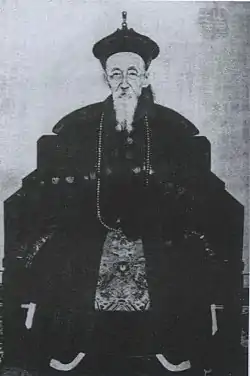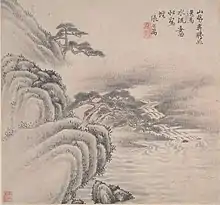

Zhang Zhiwan(Chinese: 張之萬, 1811–1897), courtesy name Ziqing(子青), art name Luanpo(鑾坡),[1] was a Qing dynasty statesman and painter.[2] He was the cousin of another prominent late Qing politician Zhang Zhidong.
Life
Zhang Zhiwan was born into a prestigious local gentry family in Nanpi. His father Zhang Yuce served as a low rank official in Zhili.[3]
Zhang's career as an official started after he passed the imperial examination as one of the three highest rank Jinshi. His first post, in the Hanlin Academy, was the compiler of chronicles. During the Taiping Rebellion, he worked as an advisor for the Qing court. Around the year of 1863, he defeated the peasants of Nian rebellion in Nanyang and Runan, at the time, he was under the military command of Sengge Rinchen. He was then moved to northern Jiangsu and was in charge of the defensives against Nian peasants until the end of the Nian rebellion.[4]
Zhang Zhiwan held the post of viceroy of water transport between 1866 and 1870. In 1871, he served shortly as the viceroy of Minzhe before being promoted to the position of the minister of war.[2]
In 1882, he was conferred the title of Secretary of Grand Secretariat. In 1884, he gained the access to the Grand Council and worked there for ten years. His colleague and superior in the council was prince Shiduo of Li. Upon the touching off of the First Sino-Japanese War, he retired himself due to his old age. He died in the year of 1897, aged 87. The imperial court bestowed the posthumous name Wenda on him. The title he held before his death was the grand secretary of the eastern pavilion(東閣大學士).[2]
Family
Zhiwan had two sons
- Zhang Jiayin(1822-1882)
- Zhang Ruiyin(1867-1922)
and four grandchildren.
- Zhang Chongfu, spouse of Li Fuzeng
- Zhang Yuanji
- Zhang Kuizheng
- Zhang Baohua
Great Grandson
- Zhang Jigao[5]
References
- ↑ Wang, Hongpeng (2004). 中国历代文状元. PLA Publishing House. p. 484. ISBN 9787506545457.
- 1 2 3 "張之萬 基本資料". Institute of History and Philology, Academia Sinica. Retrieved 2 December 2017.
- ↑ Zhang, Xiwei (1997). 历代張氏望族. Shandong Renmin Publishing House. p. 292. ISBN 9787209020916.
- ↑ Meng, Qingbing (2006). 沧州市志, Volume 4. Fangzhi Publishing House. p. 2913. ISBN 9787801927903.
- ↑ Huang, Xiuhui (2003). 張繼高: 無心插柳柳成蔭. national center for traditional arts. p. 14. ISBN 9789570152869.